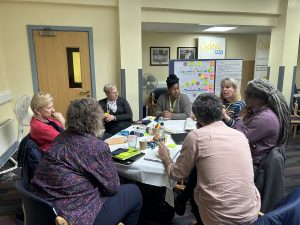Mindset XR Module 19: Dissemination

Welcome to the Mindset Extended Reality (XR) Innovation Support Programme learning resources, which include three series delivered in conjunction with our expert Mindset-XR programme partners:
• Medical regulation
• Clinical evidence
• Lived experience involvement
Mindset-XR is helping to catalyse the growth of immersive digital mental health solutions in the UK, through funding, tailored support and training. It is delivered by Innovate UK and the Health Innovation Network South London (HIN).
This series focuses on research and clinical evidence, with key insights from King's College London's Institute of Psychiatry, Psychology and Neuroscience. Across a number of modules, these resources will guide you through your research journey, from establishing what you plan to investigate, to conducting research and disseminating your findings.
Outline
Peer-reviewed publication
Presentations
Visuals
Social media/online
Reaching stakeholders
Welcome to Module 19: Dissemination. This module will be introducing the key ways to disseminate XR research. It is important to disseminate research as it lets everyone know that work has been done in this area, and the findings will inform further work beyond your research team.
In this section, we're focusing on:
Peer-reviewed publication
- Peer-reviewed publications are the main academic route of dissemination.
Things to consider:
The peer-review process often improves the article by the end. It makes sure that it stands out in the field that you're publishing in. It is the way that academia ensures quality in publication.
Peer-reviewed publications are important in the academic landscape. They're included in wider reviews and reports by bodies such as NHS and NICE. It is considered a sign of quality if the work has been published.
- It's important that publications are open access so that people don't have to pay to read them, where possible.
Presentations
It's really useful once you have the results of your project to prepare slides and content for a 10 to 15 minute talk, which outlines what you did and the key findings. You can tweak this presentation and deliver it in many different settings.
- It's important to spread the word and be open to opportunities to present your findings.
Many NHS Trusts have research coffee clubs or similar, where researchers can share their work directly with clinicians and charities. These clinicians and charities may support people that are affected by your work, and might be interested in arranging online seminars as well as many opportunities through academic settings.
Visuals
- Alternatives to the traditional formats of academic publications, reports and talks are very important.
Many of the relevant stakeholders find it difficult to access the traditional dissemination formats. There are various ways of visually presenting research and findings to overcome these challenges.
These include:
- Infographics
- Video
- Animation
- Interviews
- Role-plays or demos
- Poetry
- Blogs or prose
- Art
- This where lived experience experts can take the lead and tell you how they find it accessible and engaging to work with your projects and learn about your findings.
Below are some examples of different ways of presenting research and findings:
Social media/online
An online presence is important and it's good to invest time and energy in building a website and social media profiles that are kept up to date throughout the project.
Potential participants often find out information online and it can really help with research recruitment. It is also useful for spreading the word about your study and making sure any relevant partners know and can get in touch with you. It can be helpful to organise a launch event particularly if you're recruiting many participants, so that people know the study is happening.
Social media and online outreach also allows an international collaboration and building of networks. People can learn about your research and findings very easily through online resources. Online you can bring your research aims and results to life with visuals and lived experience input as well.
Reaching stakeholders
It is important that your dissemination strategy makes your research and findings accessible to all these groups:
- Target population of patients
- Participants
- Academics
- Technicians
- Industry
- Clinicians
- NHS and NICE
- Funders
- Patient and Publice Involvement and Engagement (PPIE) groups
Support from these stakeholders will push the project forward onto its next stage. If they know about your research, its results and its implications, they'll be inclined to support which have made the effort to communicate their findings in a way which is accessible to them.
- There are many more groups to consider that apply to your project as well, going far beyond an academic publication.
It's important to map out your stakeholders at the start. Think about how you will keep in touch with them throughout the project, and by the end once you have the results. It is often useful to ask stakeholders what formats or spaces work well to communicate with them, particularly in the NHS where people have limited time.


Next module - Module 20: Case studies
Back to Module 18: Analysis and interpretation

